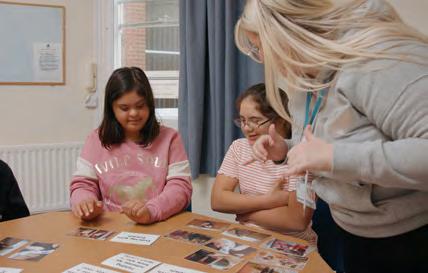
4 minute read
Teaching Emotional Literacy
As a parent of a 14-year-old with Down’s syndrome, I so often hear the words ‘happy’ or ‘sad’.
But does she really mean it? Or is it that she lacks the language and emotional literacy to say, “I’m cross, scared, or jealous.” When she lashes out at a sibling or refuses to engage in a maths lesson, how much is down to not being able to identify, label and communicate her feelings? As she heads towards adulthood, will she be able to interpret the emotions of others, allowing her to build friendships and relationships? Understanding our emotions forms the base of so many important things, from building long lasting relationships, to managing our mental health. It all stems from the basics of emotional literacy.
Emotions are an integral part of human experience and are central to our daily interactions. They shape how we perceive ourselves and the world around us, influencing our thoughts, behaviour and decision-making. Understanding emotions and their role in our lives is a crucial aspect of personal and social development, and this is particularly important for children with learning difficulties.
HOW WELL CAN YOU INTERPRET YOUR OWN EMOTIONS?
As educators, we play a critical role in supporting young people with learning difficulties to understand their emotions. One important aspect of this is for educators to be able to interpret the physical signs of their own emotions. Educators who can identify and manage their own emotions can model these skills for their students and support them in developing their emotional literacy. How often do we take that time to stop and fully ‘feel’? How does your body react when it is frightened, excited, jealous, or overwhelmed? As educators, we need to be able to identify these internal physical features of emotion so we can support our learners to identify and label their own. It is this skill that will enable us to fully engage with our learners and support them to understand their own interoception and physical signals, interpreting these to be able to better understand their emotions. Taking that time to reflect on your own internal signals is vital to supporting others to learn those skills.
Supporting Young People
When working with young people, we often hear them being accused of being ‘mean’ or even bullying, when the truth is they simply don’t understand the impact of their words. They can’t read the signals in others or themselves. They can find themselves accused of ‘inappropriate behaviour’ towards a peer, only for us to discover they didn’t fully understand how their actions affected that person. When young people with learning difficulties struggle to identify and manage their own emotions, it can lead to a range of issues. They may become overwhelmed by their emotions, leading to challenging behaviour or social withdrawal. In social situations, they may struggle to understand social cues or interpret the emotions of others. This can lead to misunderstandings, miscommunications and social isolation. It can also lead to difficulties in forming and maintaining relationships, which can have long-term negative consequences for their social and emotional wellbeing.


WHEN DO WE MOVE ON FROM TEACHING ABOUT EMOTIONS?
The simple answer is, we don’t. Unfortunately, what we often see in secondary education is an assumption that young people have the skills needed to interpret and label their own emotions. We often believe that they understand what they feel and, to some extent, can interpret the feelings of others. This can lead to educators and parents not explicitly teaching these concepts and, when things go wrong, they don’t unpick the reasons down to these most basic levels. So many of our young people need this information retaught, reinforced and consolidated on a regular basis. With so much emphasis placed on mental health and emotional resilience in the typical population (and rightly so), we mustn’t forget to give these coping mechanisms and skills to all our young people, regardless of their learning needs.

Age-appropriate resources are crucial in helping young people with learning difficulties understand emotions. When teaching about interoception, emotion identification and coping mechanisms, we need access to resources that hit the right learning levels and don’t infantilise our learners. We need clear, accessible resources that can be used right up to adulthood. They must also be simple and quick for educators and parents alike to use to guide their learning journey. That’s why Learn and Thrive, a national charity, has developed free video-guided lessons, downloadable visual resources and student packs covering this area.
As part of the Learning for Life project, Learn and Thrive has published two modules including ‘Growing Up and Keeping Safe’ and, more recently, the series covering ‘Emotions’. This series supplies video-guided lessons, activities and pointers for future learning. They are intended to provide a springboard to deeper conversation and the personalisation of the subject. The videos follow a set pattern and work through eight different emotions, with re-caps and games along the way.
You can then use the same process for any emotion you choose. Personalise the approach and discuss the individual differences for learners as part of the activities to support them to better understand their emotions and what they can do to self-regulate. The resources are designed to be used individually, in small groups, or in classrooms and they include emotions scenarios, visuals for expressions, board games and much more. The project is run by a charity inspired by young people with Down’s syndrome, and while the teaching approach is based on the learning profile of young people with Down’s syndrome, it can be differentiated for many young people with a range of learning needs.
With more content coming soon, Learn and Thrive intends to dig deeper into the RSE curriculum, covering the areas most needed by our young people in a way that is accessible to a wide range of learners with additional needs.

Overall, the importance of teaching emotional literacy to young people with learning difficulties cannot be overstated. By understanding and managing their emotions, students can improve their academic achievement, social and emotional wellbeing and their overall quality of life. Educators have a critical role to play in supporting students in this area, and age-appropriate resources can be invaluable in helping young people to develop these important skills. By working together, educators, parents and caregivers can help young people with learning difficulties to thrive and reach their full potential.











